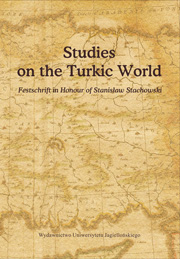Book contents
- Frontmatter
- Tabula Gratulatoria
- Contents
- Prezento de la scienca agado de prof. d-ro habil. Stanislao Stachowski
- Publications of Prof. Stanisław Stachowski
- Articles
- Bulgars and Slavs: Phonetic Features in Early Loanwords
- The Consonants ž ˜ ǧ in Kazakh
- Überlegungen zum Problem von Sprachtabus im Alttürkischen
- On the Expression of (ä)dgü kört(ä)či s(ä)n on the Bilgä Kagan Inscription
- On the Iranian Honorific Title bag, baγ, bay ‘lord, prince’
- Proto-Turkic Causative in *-g-?
- Relations entre les titres turcs qaγan, qan, qaγatun, qatun
- North-Western and Eastern Karaim Features in a Manuscript Found in Łuck
- The Importance of Bernardino Pianzola's Work for Turkish Lexicography
- Osmanische Einflüsse auf das Krim-Areal
- Turkish Proverbs in A Grammar of the Turkish Language by Thomas Vaughan (1709)
- Türk Dillerinde çilek ve yilek
- On First Syllable Reduplications in Karaim
- Names of Animals in Armeno-Kipchak: A New List Brought to Light
- Zum historisch-kulturellen Hintergrund der jenissejisch-türkischen Wortparallelen
- A New Fragment of the Mañjuśrīnāmasaṃgīti in Old Uyghur
- Ḳıṣaṣ-ı Enbiyā'dan. Eski Anadolu Türkçesinin Sözvarlığına Katkılar II
- Gezi Edebiyatının Öneminde Ahmet İhsan ve Şerafeddin Mağmumi'nin Yeri
- Das türkische Vaterunser in syrischer Schrift
- Invitation to Discussion
On First Syllable Reduplications in Karaim
from Articles
Published online by Cambridge University Press: 05 September 2014
- Frontmatter
- Tabula Gratulatoria
- Contents
- Prezento de la scienca agado de prof. d-ro habil. Stanislao Stachowski
- Publications of Prof. Stanisław Stachowski
- Articles
- Bulgars and Slavs: Phonetic Features in Early Loanwords
- The Consonants ž ˜ ǧ in Kazakh
- Überlegungen zum Problem von Sprachtabus im Alttürkischen
- On the Expression of (ä)dgü kört(ä)či s(ä)n on the Bilgä Kagan Inscription
- On the Iranian Honorific Title bag, baγ, bay ‘lord, prince’
- Proto-Turkic Causative in *-g-?
- Relations entre les titres turcs qaγan, qan, qaγatun, qatun
- North-Western and Eastern Karaim Features in a Manuscript Found in Łuck
- The Importance of Bernardino Pianzola's Work for Turkish Lexicography
- Osmanische Einflüsse auf das Krim-Areal
- Turkish Proverbs in A Grammar of the Turkish Language by Thomas Vaughan (1709)
- Türk Dillerinde çilek ve yilek
- On First Syllable Reduplications in Karaim
- Names of Animals in Armeno-Kipchak: A New List Brought to Light
- Zum historisch-kulturellen Hintergrund der jenissejisch-türkischen Wortparallelen
- A New Fragment of the Mañjuśrīnāmasaṃgīti in Old Uyghur
- Ḳıṣaṣ-ı Enbiyā'dan. Eski Anadolu Türkçesinin Sözvarlığına Katkılar II
- Gezi Edebiyatının Öneminde Ahmet İhsan ve Şerafeddin Mağmumi'nin Yeri
- Das türkische Vaterunser in syrischer Schrift
- Invitation to Discussion
Summary
0. Introductory notes
Among the many types of reduplication in the Tkc. languages, at least four are essentially a reduplication of the first syllable. One of them, the reduplication of the first syllable with an appended closing consonant, vastly outnumbers the others. It also appears to be the type usually meant when using the term first syllable reduplication in everyday speech. (Cf. 2.1.) In general, the phenomenon is poorly investigated. In particular, there does not seem to be any works devoted to its manifestation in Kar.
I decided to split the material presented here into two groups: 1. Reduplication with a closing consonant (1.1. Material, and 1.2. The closing consonant issue), and 2. other reduplications of the first syllable, i.e. taking into account the number of examples, Special cases (2.1. Actual first syllable reduplication; 2.2. Reduplication with an inserted vowel; 2.3. Reduplication with -ma- / -ta-, and 2.4. Apparent reduplications).
Notes on the presentation of the material:
– When reading the literature on Kar., one finds it difficult to escape the impression that introducing a new transcription every now and then seems to be considered good practice in the millieu of researchers in Kar. I have chosen to follow this tradition. I will use a mostly phonological notation which treats each dialect separately.
- Type
- Chapter
- Information
- Studies on the Turkic WorldA Festschrift in Honor of Stanisław Stachowski, pp. 139 - 156Publisher: Jagiellonian University PressPrint publication year: 2010



